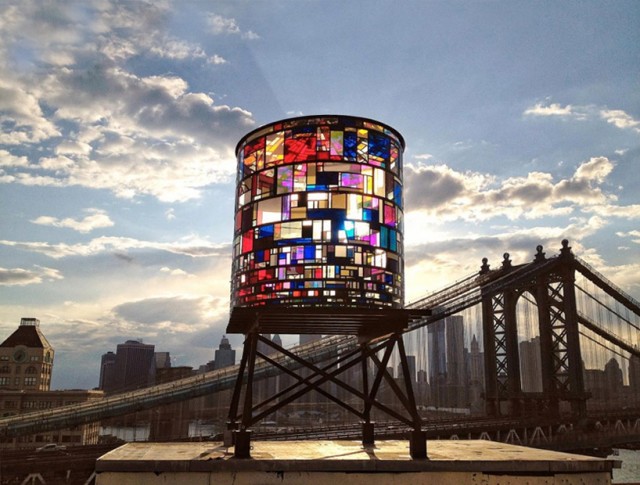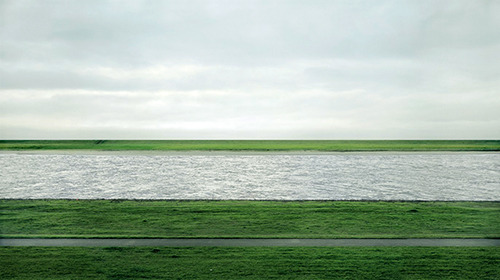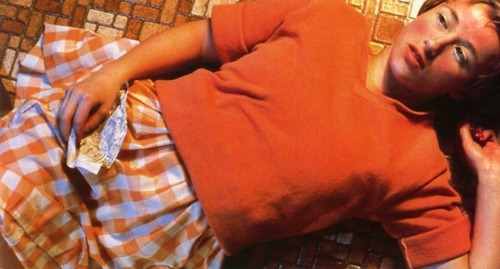Onishi Yasuaki (b.1979, Japan) - Restriction sight AAC. Plastic sheet, paper, fluorescent paint, fan, black light, others,h280, w600, d1000cm (2007)
Discovery of new artists in aichi/AICHI ARTS CENTER
[more Onishi Yasuaki | artist found at pulmonaire]
Mona Hatoum: Measure of Distance (1988) Part I /
This video piece of Hatoum involving a letter written by her mother is very moving. I’m currently preparing for a group exhibition and part of my inspiration comes from Hatoum’s piece.
4 things I learnt after exhibiting /
On Monday, I went to take down my exhibition at the C3 Contemporary Art Space. This was my first show as an undergraduate which turned out well. Here are a few things I learnt from this whole experience.
- Sitting in the gallery invigilating I met fellow exhibiting artist, Alyshia Boddenberg. I wasn’t familiar with her work before this show and I thought it was such a great opportunity to discover a new local artist, to learn about her experiences since she graduated (2008), and to network. We talked about shows we’ve seen, artists worth checking out, and about our current art practice.
- I learnt from C3 gallery manager, Jon Butt who commented ”Exhibiting artists need to spend time looking at their work to see how it stands in the space and if changes can be made.” This sounds familiar. Our teachers always encourage us to experiment different ways of hanging or displaying our works. Also you learn to work around things you can’t change about the space. Personally, I don’t think I could have hung the prints differently. The lighting was even so it was easy to display the works. There was an exit door, a fire hose, and a fire extinguisher on one of the walls which I thought would break the flow of my photo series. I worked around it and I don’t think it distracted too much.
- The third point has to do with experimenting with materials. I face mounted all my prints on polished perspex. The idea came from one of my VCA teachers, Janina Green, who suggested I tried it. I investigated the technique and spoke with Stephen Haley, the Graduate Coordinator of Research (MFA program) at VCA, who uses perspex mounting for his work. I found out that although the mounting is a bit expensive (but cheaper than framing), the glossy perspex finish not only accentuates sharpness and colour, but protects the print as well. On the down side, perspex can easily scratch but it can be polished back. Also, the print can peel off the perspex if it’s not mounted properly or humidity gets in. In the end, storing your work appropriately is important regardless of the media used. Colour Factory was the place to go for this kind of job. The final works turned out great and I’m happy with the choice I made. The feedback was positive.
- The last point has to do with the importance of documenting the show. I quickly found out that photographing a reflective surface is not ideal. I’m sure there is a way to avoid reflections. I’ll use installation shots and a few close ups, but the digital files are the most important for archival purposes.
/
A quote by Louise Bourgeois /
"Every day you have to abandon the past or accept it. If you cannot accept it, you become a sculptor."
-Louise Bourgeois (1911-2010)
Here’s the rest of the interview.
Skyline /
Watertower, A Multicolored Sculpture by Tom Fruin on the Brooklyn Skyline

The Austrian artist Tom Fruin made this installation entirely out of recycled materials. It’s very impressive.
via laughing squid
/
Nobuhiro Nakanishi. Layered Landscapes.
Impressive technique employed by Japan-born artist Nobuhiro Nakanishi who mounts his photos onto plexiglass acrylic and arranges them to create this unique effect.
Aqueous electro by Mark Mawson /
New shows at the Centre for Contemporary Photography /
Geoff Robinson
I attended the artist talks last Saturday at the CCP. Not all galleries have scheduled artist’s talks, but I find them to be the best time to find out more about the artist’s works without the hustle and bustle of openings.
The new exhibitions at the CCP feature photo prints, installation, and video. I was fascinated with the installation by Geoff Robinson in Gallery 1. I particularly liked the use of colours in his show. I’ve got chromophilia. What’s interesting is how Robinson mapped sounds from 12 different sites off Suomenlinna Island (Finland) and transformed it into something tangible and visual such as the poles. Robinson said there is no particular correlation between the colours and the sounds. The colours are definitely a contrast to the Nordic winter tones. The link to photography is found in the video installation accompanying the installation. I think Robinson found an interesting way to share his experience in Finland, enabling the audience to closely interact with their senses.It reminds me of Olafur Eliasson’s use of the elements in his installations. With Robinson’s show, you feel transported right on site with this installation and the sound recordings. The winter scenes take me back to my Canadian winters.
On a different note, the works in Gallery 2 & 3 deal with memory. ‘Lost and Found: family photos swept away by the 3.11 East Japan tsunami’ involves Japanese artists Munemasa Takahashi and Hiroshi Hatate, and the Australian artist, Kristian Haggblom. Behind the faded anonymous images and the earthy tones, there is a confronting sadness, loss, and trauma. Haggblom said he had to remove one photo because of recognisable content. In the other gallery, Eliza Hutchison displays a series of images, some of which are distorted, which explore recollection. At times, I found the content of her series ‘Hair in the Gate, a biography’ difficult to decipher without reading the titles for each photo. The way the prints are displayed is intriguing for the way the artist arranged her diptychs and triptychs.
The next work in Gallery 4, ‘Témoin oculaire: shelter or prison: a meditation on incarceration and madness’, is a perturbing yet powerful piece by the artists Julie Davies and Alex Rizkalla. The title of their show reveals it all.
On a lighter note, Charlie Sofo's night projection video, just like Robinson's exhibition, is less emotionally charged than the rest of the CCP current shows. Sofo was part of NEW 12 at ACCA earlier this year and I appreciate the similarities between his CCP and ACCA projects. Definitely worth seeing.
/
Jennifer Abessira. Elastique.
The ongoing project Elastique by JENNIFER ABESSIRA is all about the subtle acts of choice: she ambitiously juxtaposes a wide range of images, that she has found or has photographed herself, based on iconographic representation, shape, colour, position, surface perception, but also on the reference of the objects described by the artist. With a combination of nature, women’s bodies and psychedelic textures, she’s able to come up with beautiful photographs that will leave you wanting more.
And good news: her work will be part of the exhibition Irreconciliable (curated by GUY YANAI) from May 12 to June 14, 2012 at the Spaceship in Tel-Aviv, where she lives and works.
all images from the project Elastique
© JENNIFER ABESSIRA
/
Tom Waits narrates the life of John Baldessari (See Baldessari’s 109 art class assignments)
If you don’t love every little thing about this, we can’t be bros.
From YouTube credits:
The life of John Baldessari, jammed into six minutes. Narrated by Tom Waits. Commissioned by LACMA for their first annual “Art + Film Gala,” honoring John Baldessari and Clint Eastwood. Directed by Henry Joost and Ariel Schulman. Edited by Max Joseph. Written by Gabriel Nussbaum. Cinematography by Magdalena Gorka and Henry Joost. Produced by Mandy Yaeger & Erin Wright.
18 Most Expensive Photographs. /
18 Most Expensive Photographs.
1. Andreas Gursky, Rhein II (1999), $4,338,500, in November 2011.
2. Cindy Sherman, Untitled #96 (1981), $3,890,500, in May 2011.
3. Andreas Gursky, 99 Cent II Diptychon (2001), $3,346,456, in February 2007. A second print of 99 Cent II Diptychon sold for $2.48 million in…
Invite for my show at C3 Contemporary Art Space /
I’ll be part of a photography show entitled New Bodies with Isobel Taylor-Rodgers in Space B at the C3 Contemporary Art Space. The opening is on May 23rd 6-8 pm. The show runs until June 10th. I’ll be exhibiting my latest series, It’s conceivable!
Eugenia Lim - Narcissus /
Last night, I attended the video performance piece of the Melbourne artist Eugenia Lim, entitled Narcissus, held at Kings ARI. Lim explored the idea of narcissism by filming herself brushing her hair without saying anything and then replaying the video. Lim would then watch herself and would mimic some of her actions. She would start the sequence all over again.
I was curious to see Lim’s performance because I had heard about her last project, Stay Home Sakoku, where she stayed in one of the gallery spaces at West Space for 7 days. Also, the concept of narcissism is something I’ve recently started to explore and I wanted to see Lim’s perspective on it. I think she succeeded in conveying the idea using simple props, a camera, and a TV.
Eugenia Lim is a multidisciplinary artist who explores race, identity, and representation.
/
Ruth Asawa, 1952.
Ruth Asawa, Life Magazine Feature, 1954.
Ruth Asawa’s living room, 1970’s.
Untitled (S.210), 1958.
Now at the Centre for Contemporary Photography /
I attended the opening of the latest exhibition at the CCP last night. In Gallery 1 to 4 are showing respectively John Nixon, Phuong Ngo, Siri Hayes, and Mark Beehre. In the night projection window is the South Korean artist, Junebum Park.
John Nixon
The artist John Nixon (Gallery 1) was new to me. His series, Black white & grey. photographic studies (photosheets), compares and contrasts textures, shapes, and light, among other things, through close up photography. The final images are presented as 4x6” prints pasted on Manila folders. Categorization and organization are important characteristics of this series. The investigation of simple photography principles lead to abstraction, which is what Nixon is further exploring. These studies reminded me ofthe black and white abstract photos of László Moholy-Nagy. It would be interesting to see this series shot on grainy film, which would add another dimension to the exploration.
Mark Beehre
Mark Beehre (Gallery 4) was another artist new to me. His series, Men Undressed, consisted of portraits of male nudes. (Apparently, this is only the third time the CCP has ever exhibited nudes.) These men were casually posing in their own environment, staring back at the camera.The portraits explored intimacy between the viewers and the subjects. It would be noteworthy to investigate the ‘male gaze’ versus ‘female gaze’ for this exhibition. Also, if the nude subject is in a position of vulnerability, can the viewer really feel more intimate with the subject beyond feeling in a position of power?

Phuong Ngo
Siri Hayes
All you knit is love by Siri Hayes (Gallery 4) was the exhibition that impressed me the most. It involves photography, installation, and mixed media. The show consists of framed large format prints of portraits and landscapes. The framing definitely added to the overall aesthetic. This series was done during Hayes’ residency in Spain in 2010. The landscape shots are stunning and remind me of Romantic landscape paintings. Through this series, she explored a new environment from her perspective as tourist, artist, and parent. I found similarities in her interest in investigating a new place from a maternal point of view. I will become a mother soon and I’m intrigued about how other female artists’ creative process is affected by such a life changing experience. I think that Hayes managed to successfully incorporate the maternal in her series. I particularly liked the way the maternal was suggested in the use of mixed media (pearls and embroidery) in 2 of her portraits. Even the landscapes have an element of the personal incorporated in the image. I recommend Hayes’ exhibition as well as the others as all artists used the medium of photography differently and interestingly.
/
Amazing.
/
A few shots I took on film last December in Hobart.
/
Yasuaki Onishi. Reverse of Volume.
The conceptual body-scape is a theory… convoluted through form and formation. Japanese artist Yasuaki Onishi’s series ‘Reverse of Volume’ establishes this intricate premise which is about to premiere at the Rice Gallery in Houston, Texas. “I am interested in the visible and the invisible thing. Through my art work, I get information from the space and leave clues on the space. Form, color and movement is changed to the simple element, like points, lines and lights.” -Yasuaki Onishi





























